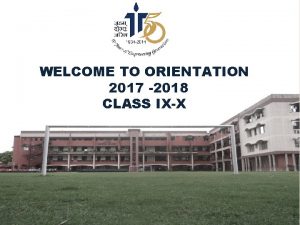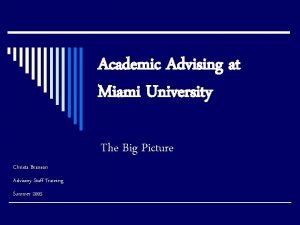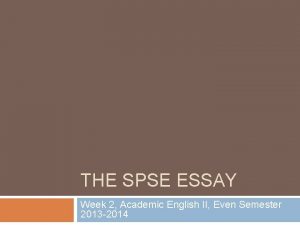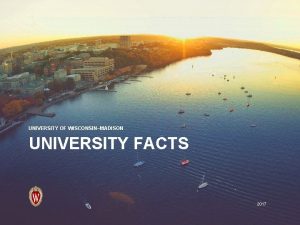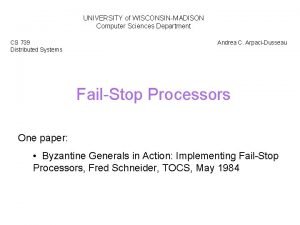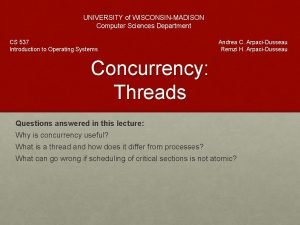University of WisconsinMadison Academic Structure ACADEMIC PLANNING AND
























- Slides: 24

University of Wisconsin-Madison Academic Structure ACADEMIC PLANNING AND INSTITUTIONAL RESEARCH

What is an academic structure? Why have one? The academic structure represents the governance approval process for the university. It makes it clear who is responsible for what. It allows campus data systems and applications to talk to each other using a common language. The academic structure is how academic activity is linked to people and money/budgets. This is a large complex institution that depends on data systems to manage its activities without a defined academic structure managing the academic enterprise would be even more difficult, time consuming and expensive. ACADEMIC PLANNING AND INSTITUTIONAL RESEARCH

0 University of Wisconsin - Madison 1 Career 2 Schools and Colleges 3 7 Subject Listings courses Departments 6 Degrees • Other supporting tables 4 Plans degree/majors, certificates, honors programs, educator certification, minors (doctoral and education) 5 - Subplans named options, honors in the major/research ACADEMIC PLANNING AND INSTITUTIONAL RESEARCH

Why are you here stating the obvious? ACADEMIC PLANNING AND INSTITUTIONAL RESEARCH

Student Digital Ecosystem ACADEMIC PLANNING AND INSTITUTIONAL RESEARCH

The Single Source of Truth Each level has: - a definition that have a foundation in the Board of Regent’s Policy, Faculty Policy and Procedures, accreditation - There is a single source of truth for the academic structure. Responsibility for maintaining the academic structure in the single source of truth is shared by APIR and the Office of the Registrar - There is a governance process for creating, changing, discontinuing items in each level Having a single source of truth will allow campus data systems and applications to talk to each other in a common language. Note – This is the academic structure: Non-academic units are outside this scope. ACADEMIC PLANNING AND INSTITUTIONAL RESEARCH

Academic Structure by the Numbers Number of codes at each level of the academic structure Level 1 - 8 Level 2 - 19 Level 3 - 154 Level 4 - 1168 Level 5 - 698 Level 6 - 205 Level 7 - 189 Number of changes in SIS needed to create the accurate single-source Level 1 - 2 Level 2 - 19 Level 3 - 239 Level 4 - 2575 Level 5 - 698 Level 6 - 219 Level 7 - 302 ACADEMIC PLANNING AND INSTITUTIONAL RESEARCH

Features, Implications, and Key Points The academic structure is a data-based representation of faculty and governance policy and actions associated with the academic units and academic programs of the university. All entries in the academic structure must be approved through faculty governance steps (department/academic unit; school/college; campus level GFEC and UAPC; BOR or subsequent steps if required). The provost or provost’s designee (currently the vice provost/director of APIR) is the sole authority to communicate the completed governance actions to the Registrar’s Office for entry into the specified SIS tables/fields. Currently that communication is via formal memo; the when fully implemented the digital curriculum/program management system will become the vehicle for communication. SIS is the system of record for the academic structure data, and any IT or data system that requires this information for operation will consume it from SIS, or from an immediately downstream source – either CAOS or Info. Access (data views to be developed). The academic structure defines the official linkage between academic programs (degrees, enrollments) and courses (course enrollments, student credit hours) and academic units (“responsible adult”/chair, faculty, instructors, staff, budgets, expenditures). Any system or record that requires a list of any of the components of the academic structure, or a link between programs and units is required to use the academic structure as the sole, official record. (Endorsed by Data Stewardship Council, August 22 2017. ) ACADEMIC PLANNING AND INSTITUTIONAL RESEARCH

http: //guide. wisc. edu/ ACADEMIC PLANNING AND INSTITUTIONAL RESEARCH

The department chairs list ACADEMIC PLANNING AND INSTITUTIONAL RESEARCH

Coming soon! Curriculum Management System - Course Proposals - Program Proposals ACADEMIC PLANNING AND INSTITUTIONAL RESEARCH

Policy This academic structure is the sole source of such information on this campus. SIS is the system of record and SIS, or CAOS or Info. Access data views (to be created) will serve as the electronic source of this information. The academic structure is a representation of academic actions approved through governance. Endorsed by Data Stewardship Council, August 22, 2017. Effective September 1, 2017 ACADEMIC PLANNING AND INSTITUTIONAL RESEARCH

apir. wisc. edu/institution/academic-structure/ Coming soon to a website near you. ACADEMIC PLANNING AND INSTITUTIONAL RESEARCH

LEVEL 1 Definition: Oversight: Source: CAREER UGRD, GRAD, LAW, MEDS, VMED, PHAR, USPC, NSTD Provost/Chancellor/HLC ACAD_CAR_TBL LEVEL 2 Definition: Oversight: Source: LEVEL 3 Definition: School/College/(Academic Division) FP&P Ch. 3. 01. A. The colleges and schools of the university are those faculty units headed by a dean. WI Statute Ch 36, Regents, FP&P/Senate, UAPC ACAD_GROUP_TBL Oversight: Source: Department/(Academic Unit) FPP Ch 5. 01. A. A department shall consist of a group of faculty members recognized by the faculty and chancellor, (and the Board of Regents, ) as dealing with a common field of knowledge or as having common or closely related scholarly interests. FPP Ch 5, UAPC, Schools/Colleges, Faculty ACAD_ORG_TBL LEVEL 4 Definition: Oversight: Source: Majors, Certificates, Honors [Plans] “An area of study—such as a major, minor, or certificate —that is within an academic career. ” Authorized by Board of Regents; also UAPC, GFEC for graduate plans, school/college, department/unit ACAD_PLAN_TBL LEVEL 5 Definition: Oversight: Source: LEVEL 6 Definition: Oversight: Source: Named Options, Honors [Subplans] Distinguishes a strand of activity within the plan of type major. Can be Option or Honors in a major. UAPC, GFEC for graduate plans, school/college, department/unit ACAD_PLAN_TBL + ACAD_SUBPLN_TBL LEVEL 7 Definition: Subject Course Subject Listings are structures for organizing groups of courses in a related subject area or topic that represent a coherent program of study. Each course Subject Listing has an academic owner, which is usually a department or other organized group of faculty (program or center) with a structured faculty executive committee. UAPC, school/college, department/unit SUBJECT_TBL Oversight: Source: Degree Award credential earned by student and conferred by University; one or many plans may have a common degree Authorized by Board of Regents; also UAPC, GFEC for graduate degrees, school/college, department/unit DEGREE_TBL + ACAD_PLAN_TBL ACADEMIC PLANNING AND INSTITUTIONAL RESEARCH

Level 1 - Careers are attached to students, students can only be enrolled in academic programs that align with their career. (ex. a student can’t be in the BA – Philosophy (UGRD) and the MD program (MEDS) simultaneously. A student is enrolled in courses under only 1 career in any given term (although the student may have multiple active careers on their student record at one time). At UW-Madison, originally aligned with separate admissions offices – undergraduate, nondegree/special, medical, law, veterinary, pharmacy, and “non-standard”. Governance – creation or deletion of an career must be approved by the Provost and Chancellor In SIS this level is represented by Academic Careers (ACAD_CAR_TBL) ACADEMIC PLANNING AND INSTITUTIONAL RESEARCH

Level 2 - School or College (Division) FP&P Ch. 3. 01 A. …the colleges and schools of the university are those faculty units headed by a dean. C. Other subunits of the university that include the term "school" in their titles are not considered schools for purposes of this chapter; they may be designated by the chancellor, in consultation with the University Committee, as equivalent to departments for any or all of the purposes described in Chapter 5. D. A school or college shall be created or discontinued, or the name of an existing school or college changed, by the chancellor after consultation with the University Committee, subject to the approval of the Board of Regents. Creation of a school or college with academic programs at the post-baccalaureate graduate or professional level is also subject to the approval of the legislature. The school/college has final responsibility for the curriculum, program review and awarding of degrees of each of the programs that it owns. Governance: Board of Regents In SIS this level is represented by Academic Groups (ACAD_GROUP_TBL) In the UDDS code structure each Level 2 has a UD. ACADEMIC PLANNING AND INSTITUTIONAL RESEARCH

Level 3 - Academic Department FP&P Ch. 5. 01 A. A department shall consist of a group of faculty members recognized by the faculty and chancellor, and the Board of Regents, as dealing with a common field of knowledge or as having common or closely related scholarly interests. A department shall be created, substantially restructured, or discontinued by the chancellor after consultation with the University Academic Planning Council, subject to the approval of the Board. C. Schools or colleges defined in 3. 01. that are not organized into departments shall operate as departments or may, by vote of the school or college faculty, organize in other ways to fulfill the objectives of this chapter. 5. 40. DEPARTMENT-LIKE BODIES. A group of faculty who are not all in the same department but who share responsibilities for departmental functions as defined in 5. 11. or departmental executive committee functions as defined in 5. 21. constitute a department-like body. Every such body shall observe the relevant provisions of Chapter 5. ACADEMIC PLANNING AND INSTITUTIONAL RESEARCH

Academic Departments (cont. ) Defining characteristics (one or more of the following) ◦ Faculty tenure home ◦ Have a subject listing ◦ Have academic “degree/majors” that awards a regent recognized credential Governance: UAPC and Faculty Senate In SIS this level is represented by Academic Organizations (ACAD_ORG_TBL). In the UDDS code structure each Level 3 has a UDD. ACADEMIC PLANNING AND INSTITUTIONAL RESEARCH

Responsibilities of an Academic Department or Department-like unit • originates all program and curricular changes through faculty governance. • assures that the curriculum is appropriate for the program, fulfills the learning goals, and is sufficiently robust and courses offered regularly so as not to hinder student progress to degree • responsible for student support services such as advising and accurate communication about the program or Subject • prepares all content for the Guide and assures that the program or Subject is represented accurately in communications about the program • oversees the course evaluation process for courses where appropriate • is responsible for assessment and program review for academic programs • is the department/academic unit to which academic activity (program enrollments, degrees, certificate awards, credits) are allocated in the information systems. ACADEMIC PLANNING AND INSTITUTIONAL RESEARCH

Level 4 - Academic Plan Minors ◦ Graduate ◦ Education programs Major/Degrees Certificates ◦ Graduate/Professional ◦ Undergraduate ◦ Capstone Undergraduate Honors programs Non-degree Programs Educator Certifications Governance: UAPC and Board of Regents In SIS this level is represented in the Academic Plan table (ACAD_PLAN_TBL). ACADEMIC PLANNING AND INSTITUTIONAL RESEARCH

Role of Academic Plans Students are declared into academic plans and this determines the curriculum they must complete and the degree they will earn. Each academic plan code represents a unique combination of School/College + Career + Area of Study. ◦ An area of study might also be called a major or discipline. Examples include: biology, interior architecture and clinical investigations There are plan codes: • for all academic programs that result in the awarding of a degree or certificate • that represent being undecided in each school/college at each degree level • that represent an intention to declare a limited enrollment program if/when admitted All plans that lead to an award have a CIP code Every plan has: ◦ Plan group ◦ School/college ◦ Defined curriculum with requirements ACADEMIC PLANNING AND INSTITUTIONAL RESEARCH

Level 5 - Academic Subplan Types of Subplans • Named Options • Honors in the major/research A named option is a formally documented sub-major within an academic major program. Named options serve as a convenient way to distinguish a distinct curriculum or delivery format within a major. A named option is NOT a new degree or major. Authorization by the Board of Regents to deliver an academic program is at the degree/major level. Named options appear on the transcript and are formally documented by the university on the student record. For undergraduate majors, they are also encoded in the degree audit system. Named options are used as a basis for advising, and are advertised to students in the Guide and through other information related to the program of study. Governance: UAPC In SIS this level is represented in the Academic Subplan table (ACAD_SUBPLN_TBL). ACADEMIC PLANNING AND INSTITUTIONAL RESEARCH

Level 6 - Degree Functionally, this is what appears on the student diploma. It is the name of the degree earned (Bachelor of Arts, Master of Fine Arts, Doctor of Medicine) and the area of study. Example: Bachelor of Science Theatre and Drama Governance: UAPC and Board of Regents In SIS this level is represented in the Degree table (DEGREE_TBL). ACADEMIC PLANNING AND INSTITUTIONAL RESEARCH

Level 7 - Subjects Course subject listings are structures for organizing groups of courses in a related subject area or topic that represent a coherent program of study. Each course Subject Listing has an academic home, which is a department or department like unit. The academic home of a subject code is determined at the time the subject code is approved. Governance: UAPC In SIS this level is represented in the Subject table (SUBJECT_TBL). ACADEMIC PLANNING AND INSTITUTIONAL RESEARCH
 Academic planning
Academic planning Dvhs academic planning
Dvhs academic planning University of oulu exchange
University of oulu exchange Miami university advising
Miami university advising Technical university of cluj-napoca academic staff
Technical university of cluj-napoca academic staff University of arkansas academic integrity
University of arkansas academic integrity Clark college advising
Clark college advising N planning
N planning Short, medium and long term planning in education
Short, medium and long term planning in education Language planning ppt
Language planning ppt Academic presentation structure
Academic presentation structure Essay structure
Essay structure New academic structure
New academic structure New academic structure
New academic structure S-p-s-e structure
S-p-s-e structure Strategic planning vs tactical planning
Strategic planning vs tactical planning Planning balance sheet in urban planning
Planning balance sheet in urban planning Role segmentation workforce planning
Role segmentation workforce planning Perencanaan agregat
Perencanaan agregat List the strategic objectives of aggregate planning
List the strategic objectives of aggregate planning Aggregate planning is capacity planning for
Aggregate planning is capacity planning for 詹景裕
詹景裕 Wbs for holiday trip
Wbs for holiday trip Hierarchy of school management
Hierarchy of school management Windows server 2003 network infrastructure
Windows server 2003 network infrastructure
